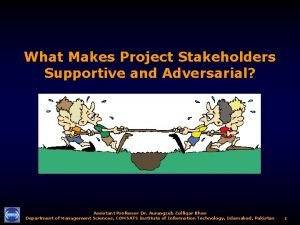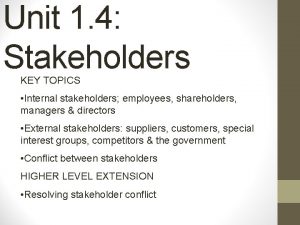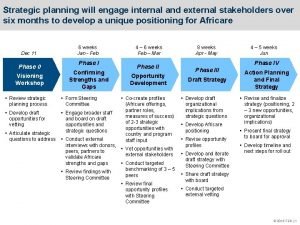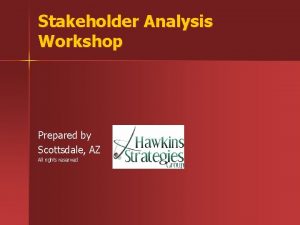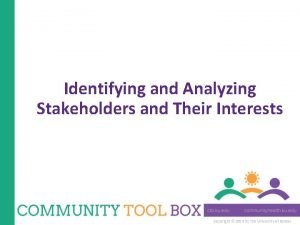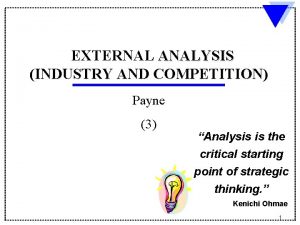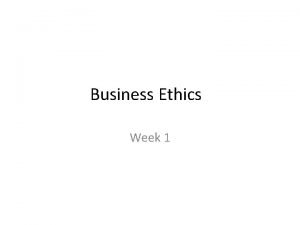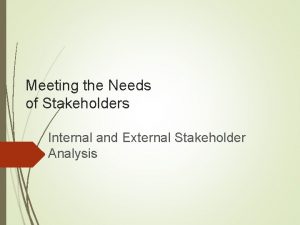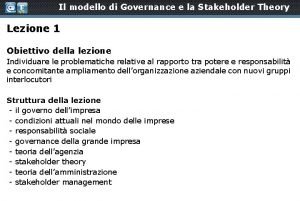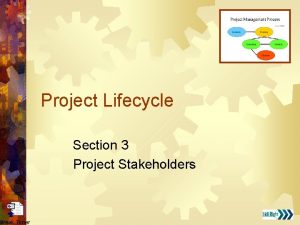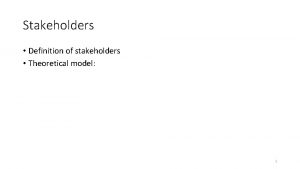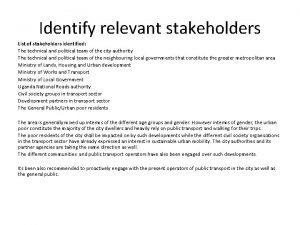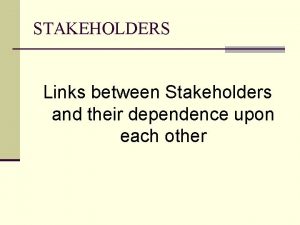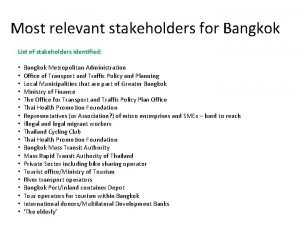Part III Techniques Chapter 11 Understanding Stakeholders A
































- Slides: 32

Part III Techniques Chapter 11 Understanding Stakeholders A group or individual with a relationship to the change, the need, or the solution Stakeholder Analysis: Identifying and analyzing the stakeholders who may be impacted by the change and assess their impact, participation, and needs throughout the business analysis activities.

BABOK® v 3 A guide to the Business Analysis Body Of Knowledge®

Stakeholder Analysis Stakeholder analysis is the act of understanding stakeholder! The ways to guide the conversation about your stakeholders on the way to establishing a plan for working with them: • Looks at the relative influence and interest of your stakeholders so you can decide how to engage them • A commitment scale can guide a conversation about how much your stakeholders support your product. … the kind of “change activities” that are needed to get stakeholder support

User Analysis Need is to understand who will use the product, what they can do, and the environment in which the product will be used! This is information is needed to guide design decisions so users can do what they are supposed to do and cannot do what they are not supposed to do. Two techniques used to structure the “conversations” 1. User modeling: structures a conversations about the user roles involved with your solution … the need is to organize the work and identify the needed functionality 2. Personas provide the means to understand the context in which the system will work. . . and is necessary for the design work

Includes: Stakeholder Map • A comprehensive list of the stakeholders involved with the project • And an understanding of how to interact with these stakeholders Example Map

Stakeholder Maps The team needs to “minimize” the chance that they have forgotten someone who is impacted by or can impact the project … the team also needs to have a better chance of having effective and efficient interactions with the stakeholders! … the team needs to avoid missing someone who would be impacted by or who could impact the project … from the start, the team needs to develop effective and efficient interactions with their stakeholders

How to use the “map”… to: • Generate a list of “all” the stakeholders – Affinity grouping (An affinity group is a group formed around a shared interest or common goal, to which individuals formally or informally belong) • Map the stakeholders based on their characteristics The need is to identify stakeholders that have influence over and/or interest in the project

Establish plans for engagement based on the characteristics and types of the stakeholders How best to engage the different “types” of stakeholders Low influence / Low interest – Monitor Low influence / High interest – Keep informed High influence / Low interest – Keep satisfied High influence / High interest – Manage closely! NOTE: Revisit you’re “analysis” if there are changes in the business environment or project goals, or organizational structure

Tool: Blank Stakeholder Map

Stakeholder Map for Commission System

Stakeholder map with actions Purchasing Network Admin Architects - DBA Accounting HR Payroll Help Desk “the Team” Sales Managers Commissions Staff Regional Managers Agents Product Development Marketing

Commitment Scale Another stakeholder analysis technique Guides the team on how best to interact with stakeholders What level of commitment is needed to ensure success? At the start of a new project and there is, as yet, no clear support project support from all stakeholders Assess the commitment level… plan for engaging stakeholders

How the “team” needs use a “Commitment Scale” Planning on how best to work with stakeholders List the various levels of commitment… Enthusiastic Help it work Compliant Hesitant Indifferent Uncooperative Opposed Hostile

Blank commitment scale

Commission system commitment scale

Managing “commitment” • Identify the key stakeholders you need to work with • Start with the most that are “influential” • Discuss with them their level of commitment and what is needed for the project to succeed • Identify the current level and also the desired levels of commitment… … and what would be needed for the project to succeed

User Modeling First, a user is anyone who receives (or will receive) value from the solution They may interact with the product or only with the product’s “results” Start with identifying an agree-upon list of user roles … … which will provide descriptions … think; user stories and other product backlog items

Example Brainstorm … to identify (at least) an initial set of Users Categorize - by each user type – their role in interacting with the product

Organize and grouping the Users Referencing the “cards” on the previous slide… Some may be “thrown away” In this example, the people building the solution should not be included… Include only those who are expecting an outcome from the solution … those that have a user “role”

Conference submission system with consolidated user roles

EXAMPLE Table 11. 1 User Roles and Descriptions Conference Submission System Case Study (Ch. 7) User Role Chair Responsibility for conference program and administers the Conference Submission System Track chair Selects the sessions for each track in the program & recommends those to be included in the program… coordinates the review committee for each track Track reviewer Reviews & advises on submissions for each track & provides coaching for presenters Submitter Submits sessions and if selected who will be the main presenter Attendee General reviewer of submission information who may or may not attend the conference. Can review some session proposal information

Personas These are used to defines typical users of a solution Helps identifying actual user roles needed to guide design decisions Personas help in the identification and design of user interaction … the context in which “users” work inform the design of the interactions

How to use Personas Identifying the user’s roles and the user characteristics relevant to the design solution. Example of roles: • • • Name A role or job title Quotes in the persona’s language Relevant demographics Description that reveals goals, motivations and pain points • Description of primary activities this user type will engage in

One collaborative way to create Personas Everyone on the team can provide input Divide the team into small groups of 3 or 4 each Place flip chart paper around the room… each representing one persona Give each group 20 minutes to create a draft persona Have the groups rotate clockwise with one person staying behind to describe what their group camp up with Repeat rotations until the groups come back to their original persona

q q Agile Practitioner Reviews on a solely volunteer basis in his spare time q Likes to review as many sessions as possible, so doesn’t waste time with partially filled out proposals, or looking at sessions he has already reviewed that have not changed q Likes to know when new sessions are posted q Finds value in Back & Forth discussions with submitters


Chapter 12: Understanding Context

Understanding Context

Deep Thought Academy Purpose-Based Alignment Model Music Education W/ local symphony 15: 1 Student Teacher Ratio Enrollment / Fundraising Bookkeeping Curriculum / Facilities Parentcommunication

Context Leadership Model

Context Leadership Model

Complexity Commission Student System Information Data System Warehouse Conferenc e Submissio n System
 Understanding your stakeholders
Understanding your stakeholders Hamlet act iii scene ii
Hamlet act iii scene ii Va handbook 5017
Va handbook 5017 Adversarial stakeholders
Adversarial stakeholders Impact of business decisions on stakeholders
Impact of business decisions on stakeholders Internal and external stakeholders examples
Internal and external stakeholders examples C level stakeholders
C level stakeholders Real estate stakeholders
Real estate stakeholders Stakeholder classification
Stakeholder classification Internal vs external stakeholders
Internal vs external stakeholders Internal stakeholders
Internal stakeholders Who are stakeholders of a company
Who are stakeholders of a company Bank stakeholders analysis
Bank stakeholders analysis Purpose of project planning
Purpose of project planning Stakeholders scuola
Stakeholders scuola Stakeholders
Stakeholders Stakeholders scuola
Stakeholders scuola Stakeholders and their interests
Stakeholders and their interests Examples of internal stakeholders
Examples of internal stakeholders Primary secondary stakeholders
Primary secondary stakeholders Who are the business stakeholders
Who are the business stakeholders Interactive social system
Interactive social system Specific and pervasive boundaries for behavior
Specific and pervasive boundaries for behavior Ford motor company stakeholders
Ford motor company stakeholders Interne stakeholders
Interne stakeholders How stakeholders impact business activity
How stakeholders impact business activity Secondary stakeholders
Secondary stakeholders Role of employees as stakeholders
Role of employees as stakeholders Stakeholders in hiv prevention
Stakeholders in hiv prevention Gym stakeholders
Gym stakeholders Stakeholder analysis presentation
Stakeholder analysis presentation Stakeholders internal and external
Stakeholders internal and external Stakeholder primari e secondari
Stakeholder primari e secondari



